InterviewSolution
This section includes InterviewSolutions, each offering curated multiple-choice questions to sharpen your knowledge and support exam preparation. Choose a topic below to get started.
| 3901. |
Observe the given figure and answer the following questions. (a) Write the complete balanced reaction for the reaction that takes place. (b) Type of reaction involved. (c) Is there any precipitate formed. (d) If any precipitate formed, write the colour of the precipitate. |
|
Answer» Solution :(a) `BaCl_(2)(AQ) + Na_(2)SO_(4)(aq) to underset("(WHITE ppt.)")(BaSO_(4)(s)) + 2NaCl(aq)` (b) It is a double displacement reaction (c) Yes, a precipitate of barium sulphate is formed. (d) The precipitate is white in colour. |
|
| 3902. |
Observe the given figure and answer the following question : Write the complete balanced reaction. |
|
Answer» Solution :The COMPLETE balanced equation is `Na_(2)SO_(4)(aq)+BaCl_(2)(aq)toBaSO_(4)(s)+2NaCl(aq)` 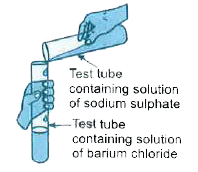
|
|
| 3903. |
Observe the given figure. Name the eye defect indicated in the figue snd also mention the lens used to correct this defect. |
|
Answer» SOLUTION :MYOPIA CONCAVE LENS 
|
|
| 3904. |
Observe the given figure and answer the following question : Is there any precipitate formed ? |
Answer» Solution :A PRECIPITATE of barium SULPHATE, `BaSO_(4)` is FORMED in the reaction.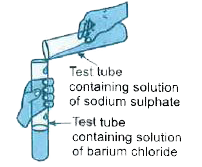
|
|
| 3905. |
Observe the given figure and answer the following question : What is the type of reaction involved ? |
Answer» SOLUTION :It is a DOUBLE DISPLACEMENT REACTION. 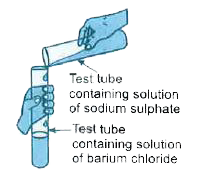
|
|
| 3906. |
Observe the given figure and answer the following question : If any precipitate is formed, write the colour of the precipitate. |
Answer» SOLUTION :COLOUR of the PRECIPITATE FORMED is WHITE. 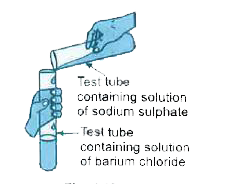
|
|
| 3907. |
Observe the given chemical change and answer the following: (i)Identify 'A' and 'B'. (ii)Write the commercial name of calcium hydroxide. (iii)Identify products 'C' and 'D' ,When HCl is allowed to react with calcium oxide. (iv)Say whether calcium oxide is acidic or basic. |
Answer» Solution : (i)A is CALCIUM carbonate.B us carbon -di-oxide. (ii)Slaked lime is the commercial name of calciumhydroxide. (iii)The products C and D are calcium chloride `(CaCl_(2))` and water `(H_(2)O)` (iv)Calcium oxide is basic in NATURE. |
|
| 3908. |
Observe the following set up : (a) Which of the bulb glows ? (b) Give reason for each of the case. (c ) What would be the change observed if the content of the beaker B is replaced by NaOH solution ? |
|
Answer» Solution :(a) Bolb C (b) Glucose and ALCOHOL do not dissociate ions when dissolved in water as they are covalent compounds. As there is no movement of ions, BULB does not glow. HCl being an acid, releases `H^(+)` when dissolved in water thereby helps in conducting ELECTRICITY. Hence the bulb glows. (c ) If beaker B is replaced by NaOH solution, the bulb glows. This is because NaOH being a base, releases OH - ions to the solution which conducts electricity. |
|
| 3909. |
Observe the following chemical reactions i) Fe_2O_3 + 2Alto 2Fe + Al_2O_3 ii) ZnO + C to Zn + CO iii) Fe_2O_3 + 3C to 2Fe + CO iv) Al_2O_3 + 3C to 2Al + 3CO Which of the above reaction is wrong? How is the metal present in the wrong equation extracted? Which of the above reaction can be used to join the broken parts of the machines. Why? |
|
Answer» Solution :Wrong reaction is (IV) It is EXTRACTED by electrolysis (i) is used to join broken PARTS `because`It is EXOTHERMIC. Fe is in LIQUID state. |
|
| 3910. |
Observe the following chemical equations : (i) Al_(2)O_(3) + 2NaOH rarr 2NaAlO_(2) + H_(2)O (ii) Al_(2)O_(3) + 6HCl rarr 2AlCl_(3) + 3H_(2)O What is the conclusion that you take about the nature of aluminium oxide with the help of these equations. Give reason for your conclusion. |
|
Answer» Solution :ALUMINIUM OXIDE is amphoteric in nature. Aluminium oxide is reacting with BASE in the first equation to give salt & WATER. Hece, it is an amphoteric oxide. |
|
| 3911. |
Observe the following chemical equations andidentify the correct statement. (i) CuSO_(4) + Fe rarr FeSO_(4) + Cu (ii) 2AgNO_(3) + Cu rarr Cu(NO_(3))_(2) + 2Ag |
|
Answer» COPPER is more REACTIVE than IRON and SILVER |
|
| 3912. |
Observe the diagram. (i) Which is concentrated solution and why?(ii) Which is dilute solution and why? |
|
Answer» SOLUTION :(i) Flask (b ) is concentrated solution. Because (b) flask CONTAINS LARGE number of solute PARTICLES than (a) flask. (i) Flask (a) is dilute solution. Because (a) flask contains lesser number of solute particles than (b) flask. 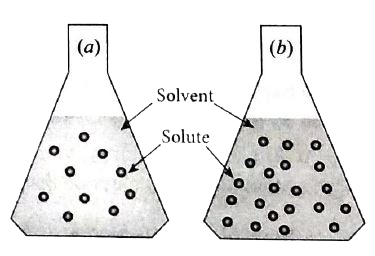
|
|
| 3913. |
O_(2),N_(2),Cl_(2),Br_(2),F_(2),I_(2) are hetero diatomic molecules. |
|
Answer» <BR> Solution :Correct statement : `O_(2),N_(2),Cl_(2),Br_(2),F_(2),I_(2)` are HOMO diatomic MOLECULES. |
|
| 3914. |
Write True/False: O_(2)^(+) has oxidation state of oxygen as +1//2. |
|
Answer» |
|
| 3915. |
Numberof water molecules as water of crystallisation present in Gypsum |
|
Answer» 2 |
|
| 3916. |
Number of moles of water in 1 L of water with density 1 g/cc are |
|
Answer» 55.56 |
|
| 3917. |
Number of carbon atoms present in 18 g of glucose ( C_(6)H_(12)O_(6)) |
|
Answer» |
|
| 3918. |
Number of atoms which a molecule to sulphur contains is ……….. . |
|
Answer» 3 |
|
| 3920. |
Number of atoms of He in 100 atoms of He (at.mass 4 amu) is |
|
Answer» 25 |
|
| 3921. |
Note: Read the assertion and reason carefully and then mark the correct option out of the options given below: Assertion (A) : Moseley showed that atomic number is a more fundamental property than atomic mass. Reason (R) : Atoms of the same element having the same atomic number but different atomic masses are called isotopes. |
|
Answer» Both (A) and (R) are TRUE and (R ) is correct EXPLANATION of the assertion. |
|
| 3922. |
Note the change in colour when a blue litmus paper is dipped in an aqueous solution of sodium hydroxide. |
| Answer» SOLUTION :No CHANGE in COLOUR. | |
| 3923. |
Note: Read the assertion and reason carefully and then mark the correct option out of the options given below: Assertion (A) : There is an anomaly in the position of hydrogen in the Periodic Table. Reason (R) : The elements Al, Si and P belong to the fourth period in the Periodic Table. |
|
Answer» Both (A) and (R) are true and (R ) is correct EXPLANATION of the ASSERTION. |
|
| 3924. |
Note: Read the assertion and reason carefully and then mark the correct option out of the options given below: Assertion (A) : Boron, silicon and germanium are metalloids. Reason (R) : The position of an element in the Periodic Table tells us about its reactivity. |
|
Answer» Both (A) and (R) are true and (R ) is CORRECT EXPLANATION of the assertion. |
|
| 3925. |
Note: Read the assertion and reason carefully and then mark the correct option out of the options given below: Assertion (A) : Non-metals like sulphur and chlorine are located on the left-hand side of the Periodic Table. Reason (R ) : Atomic radius decreases in moving from left to right in a period. |
|
Answer» Both (A) and (R) are TRUE and (R ) is CORRECT explanation of the ASSERTION. |
|
| 3926. |
Note: Read the assertion and reason carefully and then mark the correct option out of the options given below: Assertion (A) : Metallic character increases down the group. Reason (R ) : Elements in the Periodic Table are arranged in six horizontal rows called periods. |
|
Answer» Both (A) and (R) are TRUE and (R ) is correct EXPLANATION of the assertion. |
|
| 3927. |
Note: Read the assertion and reason carefully and then mark the correct option out of the options given below: Assertion (A) : Atomic size increases down the group in the Periodic Table. Reason (R ) : New shells are being added as we go down the group. |
|
Answer» Both (A) and (R) are TRUE and (R ) is correct explanation of the assertion. |
|
| 3928. |
Note: Read the assertion and reason carefully and then mark the correct option out of the options given below: Assertion (A) : There are 18 elements in the sixth period of Periodic Table. Reason (R ) :Modem Periodic Law was given by Moseley. |
|
Answer» Both (A) and (R) are TRUE and (R ) is correct explanation of the assertion. |
|
| 3929. |
Note: Read the assertion and reason carefully and then mark the correct option out of the options given below: Assertion (A) : Atomic radius decreases in moving from left to right in the Periodic Table. Reason (R ) : As we move from L.H.S. to R.H.S., the nuclear charge increases which tends to pull the electrons closer to the nucleus. |
|
Answer» Both (A) and (R) are TRUE and (R ) is correct EXPLANATION of the ASSERTION. |
|
| 3930. |
Note: Read the assertion and reason carefully and then mark the correct option out of the options given below: Assertion (A) : Metalloids have properties intermediate between the metals and non-metals. Reason (R ) : Newlands gave the Law of Triads. |
|
Answer» Both (A) and (R) are TRUE and (R ) is correct EXPLANATION of the assertion. |
|
| 3931. |
Note: Read the assertion and reason carefully and then mark the correct option out of the options given below: Assertion (A) : Position of an element in the Periodic Table tells us about its chemical reactivity. Reason (R ) : There are 18 elements in the fourth table. |
|
Answer» Both (A) and (R) are true and (R ) is CORRECT EXPLANATION of the assertion. |
|
| 3932. |
Normal Elements |
| Answer» SOLUTION :The elements in which only last shell isincompletely FILLED are CALLED as normal elements. | |
| 3933. |
Non-metals usually form |
|
Answer» ACIDIC OXIDES |
|
| 3934. |
Non-metals tend to form bonds with other atoms by gaining electrons. |
| Answer» SOLUTION :TRUE - Non-metals FORM ELECTROVALENT BONDS. | |
| 3935. |
Non-metals from |
|
Answer» IONIC halides |
|
| 3936. |
Non-metals in the third period. |
| Answer» SOLUTION :PHOSPHORUS, SULPHUR, CHLORINE and ARGON. | |
| 3937. |
Non-metals are bad conductors of electricity, except for __ which is a good conductor ofelectricity. |
| Answer» SOLUTION :GRAPHITE | |
| 3938. |
Non-metals are formed on the ____ of the Periodic Table towards the ___ ______. |
| Answer» SOLUTION :RIGHT HAND SIDE, TOP | |
| 3939. |
"Noblegases have zero electron affinity " . Say True and Falseand Justify your answer . |
|
Answer» SOLUTION :(i) True. (II) Noble gases show no tendency to accept electrons because the outers and p ORBITALS of noble gases are completely filled . (iii) No moreelectron can be ADDED to them and hence their electron affinities are ZERO. |
|
| 3942. |
Noble gases do not usually form chemical bonds. But xenon forms a number of stable compounds. Account for this. |
|
Answer» Solution :(i) comparison of atomic size of XENON with other noble gases (II) electronic configuration of xenon and atomic size of xenon (iii)scope for excited STATE configurations (IV) types of HYBRIDISATION possible |
|
| 3944. |
Noble gases are Diatomic |
| Answer» SOLUTION :FALSE. Correct Statement: NOBLE gases are monoatomic | |
| 3945. |
NoblegasesareDiatomic |
|
Answer» |
|
| 3946. |
No fixed position could be given to hydrogen in Mendeleev's Periodic table |
| Answer» Solution :HYDROGEN resembled both the alkali METALS and the halogens. So, it was PLACED above both the groups and could not be given a fixed POSITION in Mendeleev.s Periodic Table | |
| 3947. |
No fixed position can be assigned to hydrogen in the periodic table. |
|
Answer» Solution :ELECTRONIC configuration of hydrogen resembles with alkali METALS. Like alkali metals, hydrogen combines with halogens, oxygen and sulphur to form compounds having similar formulae. Hydrogen also resembles halogens as it exists in the form of diatomic MOLECULES. Hydrogen combines with metals and non-metals to form ionic and covalent bonds respectively. Thus, hydrogen cannot be assigned fixed position in the PERIODIC table. |
|
| 3949. |
Nitrogen in soil is an example of solution in nature. |
|
Answer» SATURATED |
|
| 3950. |
Nitrogen in soil is an example for super saturated solution. |
|
Answer» |
|